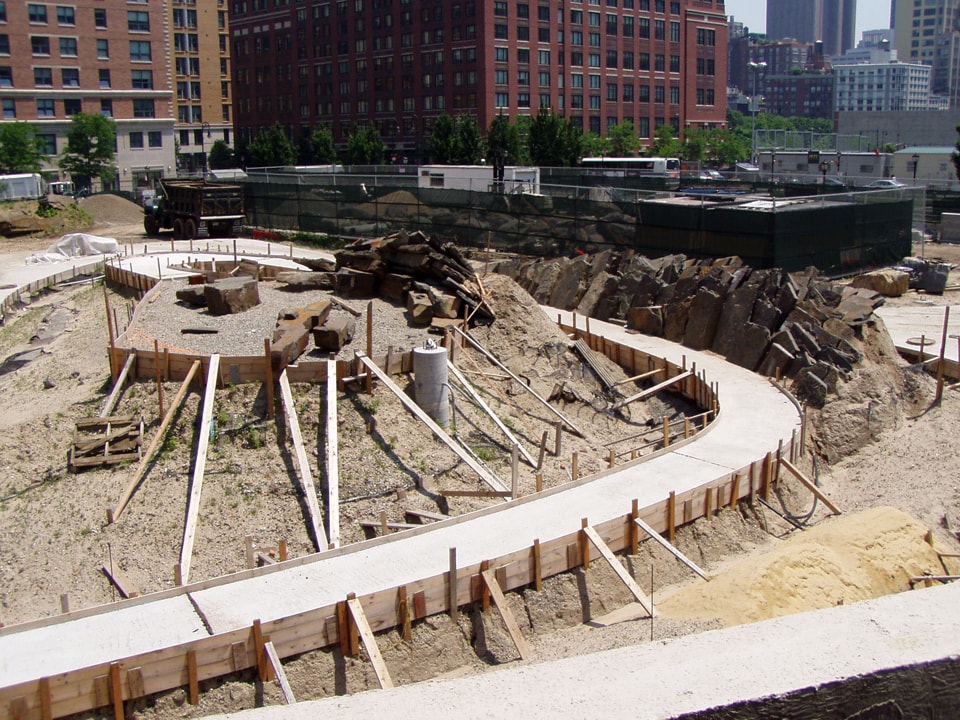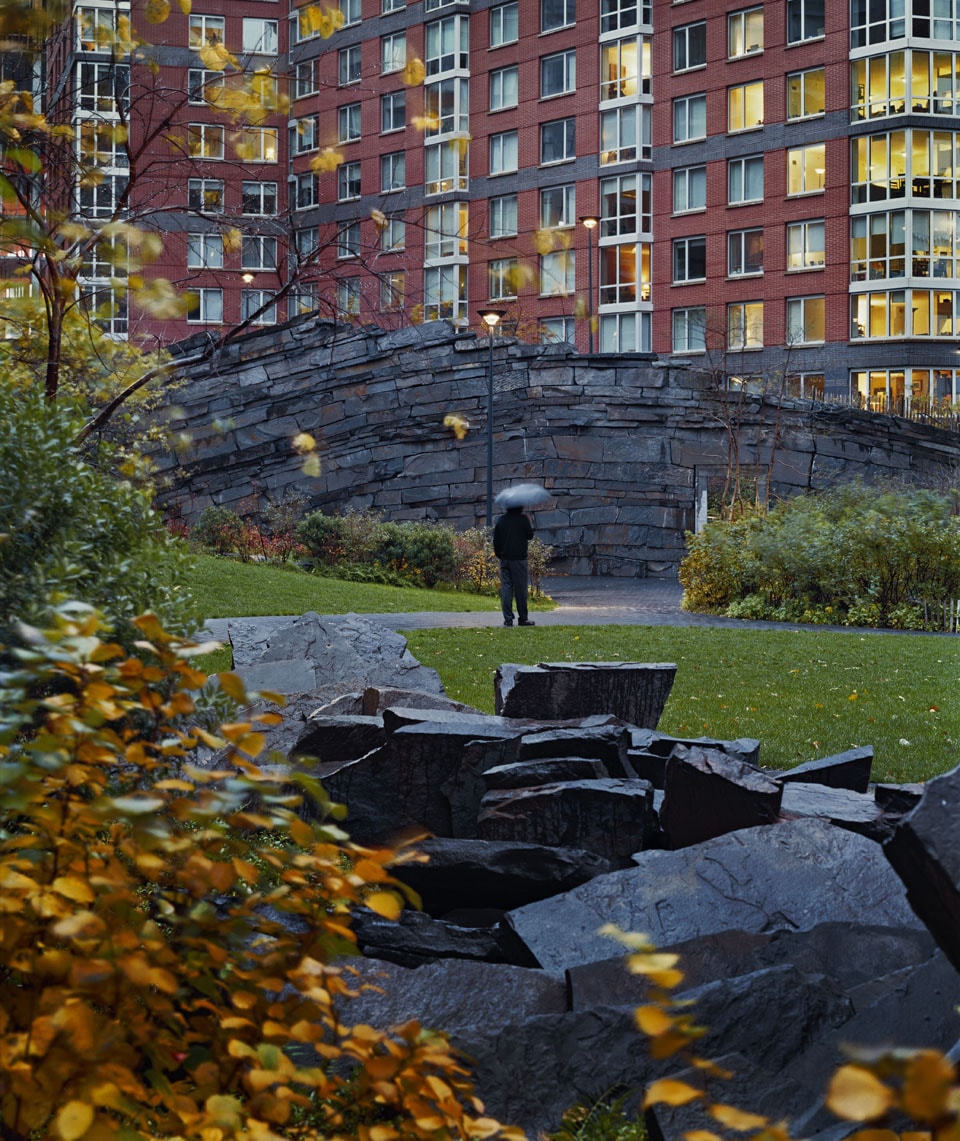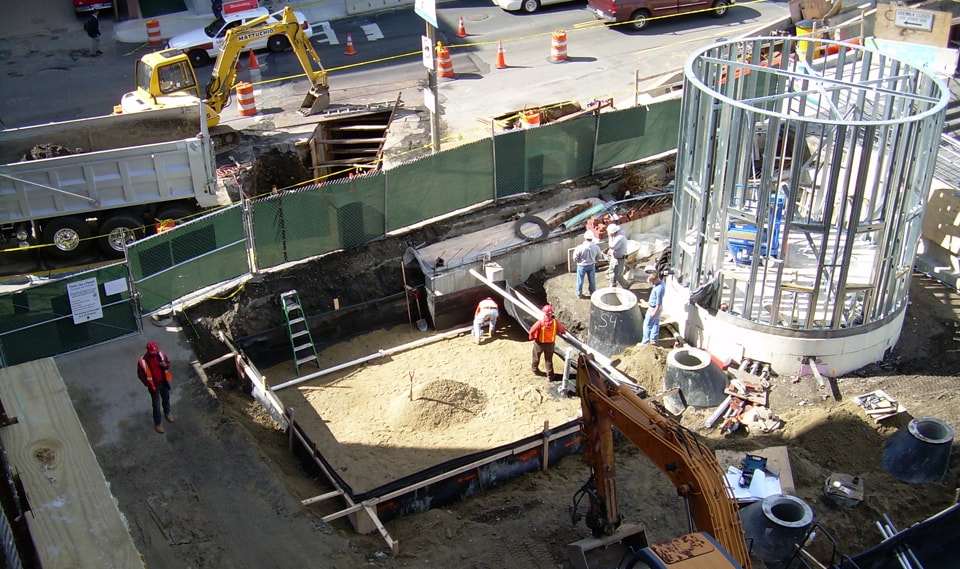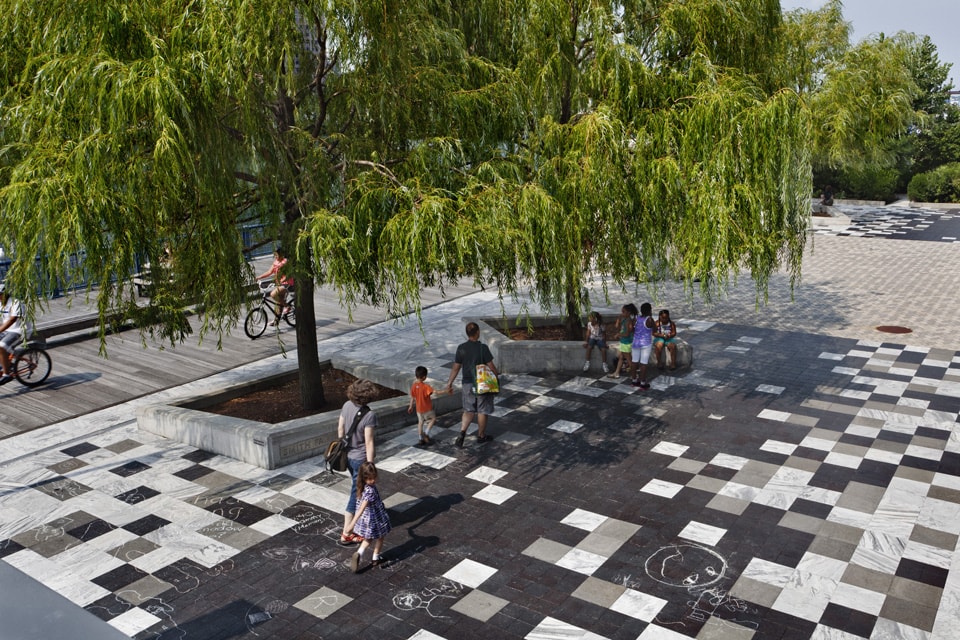Look down. If you are in a city or large town, below you is a vast network of hidden systems that support your life: pipes that carry natural gas, potable water, stormwater, sewage, and communications wires. These pipes rarely come to mind, but we agree that their operation is for the common good, that survival is not possible without them, and that armies of workers should keep them running. Surrounding those pipes are soils that are equally critical to our existence but to which we give much less attention. If we truly understood the delicacy of soil as a dynamic living system integral to the health of our towns and cities, our neighborhoods and families, we would be more cautious about how it is perceived, treated, and protected. Healthy soil performs important functions such as sequestering CO2, mitigating stormwater runoff, supporting plant life, and sustaining the microbial populations that form the basis for all living things. So essential and complex are the conditions for soils in more developed areas that a new branch of science has arisen and is now being intensively pursued: the science of urban soils.
The Teardrop Park site had no existing soil, so all planting soil was imported. Special bracing allowed concrete to be installed before soils, which prevented compaction of adjacent 3’ deep plant beds. Photo by MVVA
The Challenges of Urban Soils
Urban soils are are naturally-occurring soils that have been disturbed by development in a way that affects their functioning and properties. Urban soils are distinguished by a number of similar features: Their horizons (the natural vertical order of soils) have become jumbled by excavation. This makes urban soil horizons confoundingly diverse; one layer may be hospitable, but adjacent layers may not be, creating abrupt changes that can cause impermeable interfaces. Soil structure (the balance of solids and pores) has been crushed out of existence by mechanical compaction that chokes off water and air exchange. Organic matter (the source of plant nutrients) is low or missing from lack of replenishment, and this imbalances the soil biological community (bacteria, fungi, nematodes, arthropods, earthworms, insects, and more). Soil volumes that are important for plant health decrease because of interruptions from urban debris such as construction waste and rocks. Finally, the predominance of pavement separates soils from natural inputs such as nutrient-rich leaf litter, and this separation causes the nutrient cycling system to slow or shut down.
In the urban environment, soils are likely to be sealed off from the agents that build healthy soil—including wind, precipitation, ice, temperature, gravity, and mineralization—which frequently have been replaced by anthropogenic processes detrimental to soil functioning. Urban soils often become defined by human activities and land use histories at a particular location rather than by the continuum of geologic processes. This disrupted order makes urban soils particularly challenging to analyze, manage, and construct.
Soil depths and formulas were calibrated for each planting condition at Teardrop Park. Lawns have 18” of compaction-resistant soil while plant beds have highly organic, less sandy soil. Photo by Paul Warchol
Urban Soils in the Service of Stormwater Management
Urban soils have the potential to be an important partner in stormwater management, use, and protection. The Natural Resources Conservation Service has recognized that soils with good infiltration and permeability can significantly reduce stormwater runoff rates and volumes that might otherwise overwhelm and impair the performance of the chain of water bodies that sustain our water supplies and the ecosystems that are necessary for healthy living [1]. Good infiltration reduces runoff by letting water soak into soils before it builds up to damaging volumes and velocities that would erode topsoil and carry both silts and pollutants to waterways. Permeability influences how quickly absorbed water drains through soil to useful depths for plants and recharge. Water that reaches root zones reduces irrigation needs. Some soil can filter toxic compounds or excess nutrients by holding them, degrading them, or otherwise making them unavailable. All of these benefits are feasible when soil has adequate pore space, which is only possible when soil’s natural physical texture and structure have been preserved or created.
Over-compaction of soils is one of the greatest deterrents to implementing best practices for stormwater management, because crushed particles minimize pore space and prevent water and air from moving through. In a study by the University of Florida, soil compaction from construction vehicles reduced infiltration by 70 to 90% [2]. This is perilously close to impermeable pavement.While people recognize that reducing pavement is the primary way to improve stormwater management, few see the same connection with soil. It is not enough to substitute pavement with plant beds if nothing has been done to prevent construction compaction. Without a soil management plan that includes practices for dealing with compaction before, during, and after development, urban soils will continue to become, plot by plot, a decommissioned resource in stormwater management.
A Partnership between Urban Soils and Vegetation
The greatest positive effect of healthy urban soil is most evident in plants, the workhorses of the environment that clean the air, absorb CO2, abate high temperatures, support wildlife, slow stormwater runoff, and keep erosion in check. In recent years, there has been resurgence in support for increasing the vegetation and tree cover in American cities. We are well aware of the positive ecological, social,[3] and economic value of plants for individual properties, community open space, and urban regions [4]. Ecologically, a single large tree in the city is said to be ten to twenty times more beneficial to the environment than a single tree in the forest [5]. Yet the health of urban trees is declining at a rapid rate. A recent study by the U.S. Forest Service looked at twenty cities and found that they are losing tree canopy cover on average by 3% per year [6]. While this loss may seem small, over time the cumulative effects are severe. For example, Washington, D.C. lost 64% of its acreage-coverage from 1973 to 1999 at an average annual rate of 2.5% [7]. Still we continue to ignore the most basic need of trees: healthy soils. On most urban sites, fertile topsoil is absent, plant roots are restricted, air and water movement is suppressed, and nutrients cannot be exchanged. All this puts plants at an extreme disadvantage. The evidence of poor soil is all around, telegraphed by unhealthy plants. So if trees are to become “beautiful utilities” as urban tree expert Henry Arnold [8] suggests, then soil must also be treated in projects as an essential utility: analyzed, engineered, budgeted, scrutinized, and maintained.
The existing seawall at the Boston Children’s Museum let salt water inundate natural soils, rendering planting impossible. Custom waterproof plant boxes made from sheets of landfill liners hold new soil, sealing it from the Fort Point Channel waters. Photo by MVVA
Advocating for Soil
There are sound economic reasons to invest in good soil. As one of the core infrastructural materials in every urban landscape project, soil needs only to be tended more carefully to make it a viable component of stormwater management. Using soils to store and retain water as part of the stormwater management system can reduce costs for piping, drainage structures, runoff storage tanks, irrigation systems, and infrastructure maintenance and can provide more flexibility in design, since hard systems can add horizontal and vertical complexity that limits design options. Plants (especially street trees) with well-functioning soil are more able to start and sustain the nutrient cycling system without big infusions of maintenance after establishment and in maturity. When they do get maintenance, they are more likely to respond. Healthy soils beget trees that live longer and grow bigger, enabling them to cast more shade, and absorb more CO2, and runoff. Even asphalt benefits from healthy trees, since shade improves its performance and durability [8]. Last, trees in good quality soil are far less prone to infection and pests, virtually eliminating the need for chemical treatments [9]. Investing in soil is critical for the long-term health of urban trees and by extension for the success of sustainable landscape projects and green infrastructure programs.
Why then do urban soils get so little attention when they are such a critical part of our environmental infrastructure and, ultimately, of human well-being? Some of the unawareness stems from societal and governmental ignorance. While keeping water and air usable is an unquestioned necessity, few people have the same association with city soils. For the most part, urban soil is considered mysterious, complex, and costly. Design professionals have an important role to play in dispelling unwarranted concerns and helping solve tangible problems: They should lead the way, project by project, educating their clients, agencies, and others about the need for healthy soil. Before that happens, designers must step up their own soil education. My interactions with colleagues suggest a dearth of understanding of basic soil science and the need for soil management in landscape projects. Often other landscape architects reach out for soil advice only when something has gone wrong. Designers do however have a thirst for this information as is shown by the increasing number of packed sessions in soil education at the annual meeting of the American Society of Landscape Architects (ASLA), the professions’ largest organization. Perhaps the neglect is also due to the fact that soil is not yet a hip topic; it has no visual presence. For many, design attention is reserved for visual effects; the hidden, infrastructural elements of landscape have long been considered the domain of engineers and scientists.
In my work as a landscape architect at Michael Van Valkenburgh Associates, soil discussions begin early, sometimes in the concept phase and always by schematic design. Soil is always an item on the design checklist. Just as all practitioners request surveys to locate utility lines, we request USDA soil tests to understand what we have to work with. Partnering with soil scientists, we have learned to interpret laboratory tests so we can ask the right questions and frame discussions. We keep up with developments in soil science (biology is the big topic now), often consult allied professionals, incorporate quality control practices into our specifications, and closely monitor sourcing, blending, and installing of soils during construction. We consider soil rigorously, as we do any other product or system in our projects.
I don’t mean to imply that assuring good soil is obvious or easy; it is neither, even for a firm that has been attempting it for twenty years. Every project brings unique soil challenges and clients with different agendas. The client may be unfamiliar with non-traditional stormwater approaches and therefore reluctant to consider soil-dependent systems. Brownfield properties often have contaminated soil or no useful soil at all. In other kinds of properties, existing soils could be reused if amended, but space may be too limited to manage soil-blending operations. Sometimes soil chemistry is limiting. For example: elevated pH from concrete or limestone rubble can interrupt nutrient exchange and narrow plant selection; high salinity in soil near tidal waters wreaks havoc on water uptake and cellular structure in plants. Local contractors often have no experience with installing designed soils. In my experience, construction managers show little tolerance for any aspect of landscape construction that is dynamic, an inherent characteristic of soil in particular and landscapes in general. Unless we have a repeat client, the process of educating, convincing, and making monetary tradeoffs to get good soil starts anew on every project. Sometimes we battle the sins of others’ projects in which someone tried but failed to improve soils. Projects with unsuccessful or difficult soil processes often produce rumors that the landscape architect specified unrealistic soils that cost too much and slowed the schedule, even if the problem was caused by the laxity of a member outside the design team.
Shown here in 2012, the subsurface box planters at Boston’s Children’s Museum hold willow trees installed in 2006. Photo by Elizabeth Felicella.
Repositioning Soil as Infrastructure
How can we begin a campaign for good urban soil? We can start by talking with city hall, one of the biggest makers of landscapes and planters of trees, about the importance of soil. How many of the thousands of landscapes planted every year include soil improvement? Atlanta, Detroit, Denver, Los Angeles, and many other cities have tree-planting programs. Ambitious past and current mayors like Richard Daley and Michael Bloomberg launched campaigns to plant a million trees. Despite current commitments to increasing urban vegetation through tree planting, under current practices the mortality rate for young street trees is shockingly high: Some studies have found that over twenty-five percent of newly planted trees die within two years of installation [10,11], wasting already strained public funds and leaving behind a depressing reminder of failed nature. Wouldn’t it be more strategic to forgo planning one million trees in poor soil and instead plant 500,000 trees in good soil? [12]
To be stewards of urban soils, we need to ask pointed questions early in and throughout projects and insist on satisfactory answers that ensure positive long-term results for stormwater and planting. When zoning requires developers to add or replace trees, we need to ask for more than in-kind caliper inches and to require a soil management plan. When contractors install soil, they need to treat it like the valuable commodity it is or bear the cost of remediation. State and municipal specifications (which are used by contractors defensively instead of proactively) already define which dirt is suitable for backfill—why not extend this thinking to include requirements for the type, procurement, handling, and installation of planting soil? Landscape architects and anyone else who works with the landscape need to heed these too. Such guidelines should not be overly technical or onerous. Plant species should be matched to soil conditions, especially its pH and water supply. Trees should be planted at the right elevation to expose the root flare so soil doesn’t suffocate the tree. Adequate soil volume (800 to 1400 cubic feet per tree) and shared root space to encourage root spread should be provided [13]. Soils should be arranged to mimic the horizons in nature in which the top is rich in nutrients, the middle has the correct structure to encourage root growth, and the bottom is drainable. To resist compaction and maintain water and air exchange, soils higher in medium-to-coarse sands (rather than easily compactable fine sands and loam) should be used, and limits on density should then be set. Wet or frozen soils should not be moved or installed. To promote water and air exchange, rootball zones in tree pits should be exposed and at least half of the surface area of a plant bed should be left open, or a simple aeration system should be installed. Well-aged compost should be used to to provide 5% to 10% organics to the top layer of soils. And last, utilities should be placed at least three feet from trees.
There are more technical elements and specifications to consider, especially for sites with no soils, but as Stuart Shillaber the superintendent of horticulture at Boston’s Rose Fitzgerald Kennedy Greenway Conservancy advised me recently about introducing organic maintenance, “be happy when someone can implement 60% of the program. The rest will come when clients see results.”
The installation and upkeep of our existing “hard” utility systems requires substantial public and private investment. Creating well-functioning soils would not require large funds from the public since this work can be achieved project by project. Upkeep of hard utilities is costly and disruptive; not so for soils that can be tended several times a year with substantially less trouble. The ASLA estimates that every year nearly 4.6 million acres are affected by public and private landscape projects [14]. Making headway on a quarter to third of that amount would start a revolution.
The Future of Urban Soils
From my vantage point, prospects for improving urban soils are good. In my thirty-year career as a landscape architect, there has never been a time of greater interest, research, and resources for managing urban soils and as many successfully constructed projects using urban soils. Advocacy for higher quality soil is rising nearly forty years after Dr. Phil Craul (professor emeritus at SUNY) and his colleagues started the field studies on urban soils that led to his 1992 publishing of the seminal Urban Soil in Landscape Design. Today, the USDA’s National Resources Conservation Service has substantial mapping, literature, and research on urban soils [15]. Ted Hartsig, a division chair of the Soil Science Society of America, tells me that the organization recently formed an urban soils division and committee whose focus is issues of urban soils including morphology and classification, the relationship of chemicals and nutrient quality, physics, biology, and structure, as well as the restoration and management of these soils. Urban soils studies are proliferating at public and private universities like Johns Hopkins and Kansas State.
Most critically, the public is starting to understand at the personal level of their gardens that the old adage “better to put a $5 tree in a $50 hole than to put a $50 tree in a $5 hole” is correct. Remember that until professionals and individuals teamed together to demand action, climate change was downplayed. Landscape architects and other professionals must play a part, whether through projects, lobbying our government, writing articles, lecturing, self-education, or speaking up in any propitious situation. We can be plausible leaders in the discussion to invest in another underworld utility, the first that is purely for the public good.
 Laura Solano is a Principal at Michael Van Valkenburgh Associates in Cambridge, MA and an Adjunct Associate Professor at Harvard University’s Graduate School of Design. In practice for over 30 years, Laura has been an integral contributor to many of MVVA’s best-known landscapes, including: Teardrop Park, Restoration of Pennsylvania Avenue in front of the White House, the George W. Bush Presidential Center, Boston Children’s Museum Entry Plaza, and Don River Park in Toronto. She lectures across the US on technology, was on the Soils Committee for the Sustainable Sites Initiative, is featured in the film “Leaders in the Field: Women in Landscape Architecture”, and is a board member of the Landscape Architecture Foundation.
Laura Solano is a Principal at Michael Van Valkenburgh Associates in Cambridge, MA and an Adjunct Associate Professor at Harvard University’s Graduate School of Design. In practice for over 30 years, Laura has been an integral contributor to many of MVVA’s best-known landscapes, including: Teardrop Park, Restoration of Pennsylvania Avenue in front of the White House, the George W. Bush Presidential Center, Boston Children’s Museum Entry Plaza, and Don River Park in Toronto. She lectures across the US on technology, was on the Soils Committee for the Sustainable Sites Initiative, is featured in the film “Leaders in the Field: Women in Landscape Architecture”, and is a board member of the Landscape Architecture Foundation.




